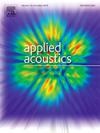Vibroacoustic characteristics of a metamaterial plate cavity coupling system
IF 3.4
2区 物理与天体物理
Q1 ACOUSTICS
引用次数: 0
Abstract
Metamaterials have garnered significant attention due to their remarkable ability to control low-frequency vibration and noise, particularly in applications involving underwater vehicles. This article specifically examines the vibration and acoustic properties of a metamaterial plate cavity coupling system (MPCCS). The mathematical model for the MPCCS is established using principles of energy functional and polynomial expansion. The study explores the bandgap characteristics, coupling modes, and mechanisms of vibration and sound reduction within the system. The key findings reveal that the MPCCS can generate two distinct low-frequency bandgaps, with the starting frequency remaining consistent across various cavity mediums, while the bandwidth varies. Within these band gaps, both vibration and cavity pressure experience significant reduction. To validate these findings, an underwater experiment on sound and vibration control using the metamaterial plate is conducted in an anechoic tank. Results demonstrate the effectiveness of the metamaterial plate in controlling vibration and acoustics compared to a bare plate, highlighting the dual bandgap characteristics of the lateral local resonance metamaterial plate. Furthermore, the experimental outcomes strongly confirm the metamaterial plate’s capability to achieve vibroacoustic control within specific frequency ranges, namely the bandgaps. These findings provide valuable insights and practical guidance for engineering applications, particularly in the design and optimization of metamaterial-based systems for controlling vibration and noise, especially in underwater environments.

求助全文
约1分钟内获得全文
求助全文
来源期刊

Applied Acoustics
物理-声学
CiteScore
7.40
自引率
11.80%
发文量
618
审稿时长
7.5 months
期刊介绍:
Since its launch in 1968, Applied Acoustics has been publishing high quality research papers providing state-of-the-art coverage of research findings for engineers and scientists involved in applications of acoustics in the widest sense.
Applied Acoustics looks not only at recent developments in the understanding of acoustics but also at ways of exploiting that understanding. The Journal aims to encourage the exchange of practical experience through publication and in so doing creates a fund of technological information that can be used for solving related problems. The presentation of information in graphical or tabular form is especially encouraged. If a report of a mathematical development is a necessary part of a paper it is important to ensure that it is there only as an integral part of a practical solution to a problem and is supported by data. Applied Acoustics encourages the exchange of practical experience in the following ways: • Complete Papers • Short Technical Notes • Review Articles; and thereby provides a wealth of technological information that can be used to solve related problems.
Manuscripts that address all fields of applications of acoustics ranging from medicine and NDT to the environment and buildings are welcome.
 求助内容:
求助内容: 应助结果提醒方式:
应助结果提醒方式:


